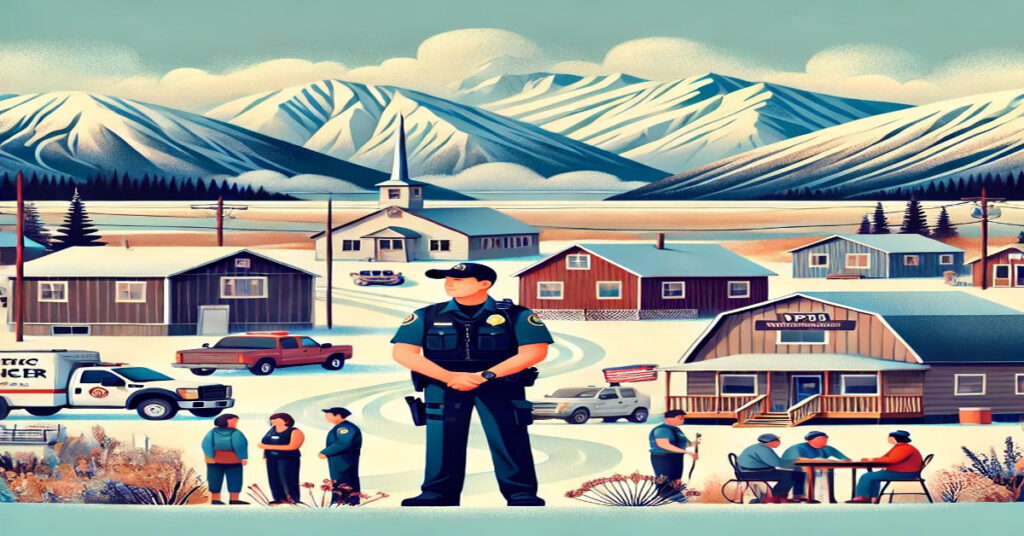The Village Public Safety Officer (VPSO) program is a cornerstone initiative in Alaska aimed at bridging the gap in emergency and safety services in rural and remote areas. Introduced in 1979 the VPSO program was created to address the unique challenges of providing public safety in sparsely populated and geographically isolated communities. Over the years, the program has evolved into a multifaceted solution that not only ensures emergency response but also fosters a sense of security and resilience within these communities.
This article explores the history, roles, training, and impact of VPSOs in Alaska, shedding light on their critical importance in maintaining public safety in some of the most challenging terrains in the United States.
The Origins of the VPSO Program
Addressing Rural Public Safety Challenges
Rural Alaska poses unique public safety challenges due to its vast distances, limited infrastructure, and extreme weather conditions. Before the VPSO program, residents in remote areas often faced delayed response times for emergencies, from law enforcement issues to medical crises. Recognizing this gap, the VPSO program was conceptualized to provide a localized safety solution.
The Vision Behind VPSO
The primary goal of the VPSO program was to train and certify local individuals to serve as peace officers within their own communities. This model ensured not only faster emergency response but also an ongoing, proactive public safety presence.
What Does a VPSO Do?
A Multifaceted Role
Certified Village Public Safety Officers take on a variety of responsibilities to ensure the safety and well-being of their communities, including:
- Law Enforcement: VPSOs act as peace officers, handling basic law enforcement duties such as enforcing local laws, mediating disputes, and maintaining order.
- Emergency Medical Assistance: They provide first aid and basic medical support, often serving as the first point of contact in medical emergencies.
- Fire Protection: VPSOs are trained to manage fire prevention and suppression efforts, including educating the community about fire safety.
- Search and Rescue Operations: In Alaska’s rugged and often unforgiving terrain, VPSOs play a critical role in coordinating and conducting search and rescue missions.
- Crime Prevention and Community Policing: Engaging with community members to build trust and reduce the likelihood of crime is a cornerstone of the VPSO’s role.
- Public Education: VPSOs often organize safety training programs and awareness campaigns tailored to the unique needs of their communities.
The Training and Certification of VPSOs
Comprehensive Training Programs
Becoming a VPSO requires rigorous training to equip officers with the skills necessary to handle diverse emergencies. Training typically includes:
- Law Enforcement Basics: Handling arrests, evidence collection, and report writing.
- Medical First Response: CPR, basic first aid, and trauma care.
- Firefighting Techniques: Fire suppression and evacuation protocols.
- Crisis Management: Strategies for de-escalating tense situations and mediating conflicts.
- Search and Rescue Skills: Navigation, survival tactics, and teamwork in extreme conditions.
Certification and Ongoing Education
After initial training, VPSOs must meet state certification requirements. Additionally, they often participate in ongoing education to stay updated on best practices, legal changes, and advanced safety techniques.
The Impact of VPSOs on Rural Communities
Reducing Emergency Response Times
With VPSOs stationed in remote villages, the time it takes to respond to emergencies is significantly reduced. This can be the difference between life and death in situations like medical crises or natural disasters.
Building Community Trust
The presence of a VPSO fosters a sense of security within the community. Their dual role as enforcers of the law and community allies strengthens bonds and encourages cooperation.
Economic and Social Benefits
By employing individuals from within the community, the VPSO program not only creates jobs but also ensures cultural and social alignment, which is crucial for effective communication and trust-building.
Challenges Faced by the VPSO Program
Recruitment and Retention
Attracting and retaining qualified individuals for the VPSO program is a persistent challenge due to the demanding nature of the job and the remote locations.
Funding Constraints
The program relies heavily on funding from state and federal sources. Budget cuts can impact training, equipment, and the number of officers deployed.
Safety Concerns
VPSOs often work alone in isolated areas, which can expose them to risks without immediate backup.
The Future of the VPSO Program
Leveraging Technology
To overcome geographic and logistical challenges, the program is exploring advancements such as:
- Satellite Communications: Ensuring constant connectivity for remote officers.
- Drones for Search and Rescue: Enhancing efficiency in finding missing individuals.
- Mobile Training Programs: Bringing advanced training to remote areas.
Expanding Roles
As community needs evolve, VPSOs are likely to take on additional responsibilities, such as disaster preparedness and mental health crisis intervention.
How to Become a VPSO
Basic Requirements
To qualify as a VPSO, candidates typically need to:
- Be at least 21 years old.
- Hold a high school diploma or equivalent.
- Pass background checks and drug screenings.
Application Process
Prospective VPSOs must complete an application process, which includes interviews, fitness tests, and submission of relevant documentation.
Training Enrollment
Successful applicants are enrolled in an intensive training program, often held at state or regional facilities.
Why the VPSO Program Matters
The VPSO program stands as a testament to the power of localized solutions in addressing unique public safety challenges. By training individuals to serve their own communities, Alaska has created a model that ensures culturally sensitive, efficient and proactive public safety services.
Conclusion
The Village Public Safety Officer program is a lifeline for Alaska’s rural communities, addressing critical public safety needs with localized expertise and unwavering dedication. From ensuring swift emergency responses to fostering community trust, VPSOs play a multifaceted role that goes beyond traditional law enforcement.
Despite the challenges, the program’s adaptability and commitment to innovation position it as a model for addressing public safety in remote and underserved areas. By investing in the VPSO program and supporting its officers, Alaska continues to set a precedent for effective rural public safety solutions.
FAQs
1. What does VPSO stand for?
VPSO stands for Village Public Safety Officer.
2. What is the main role of a VPSO?
A VPSO provides law enforcement, emergency medical assistance, fire protection, and community safety services in rural Alaska.
3. How are VPSOs trained?
VPSOs undergo comprehensive training in areas such as law enforcement, medical response, firefighting, and search and rescue.
4. Are VPSOs armed?
Policies regarding arming VPSOs vary, but historically, many VPSOs have not carried firearms. Recent discussions have considered changes to this policy.
5. How is the VPSO program funded?
The program is funded through a combination of state, federal, and local resources.
6. What challenges do VPSOs face?
VPSOs face challenges such as working in isolation, recruitment and retention issues, and limited funding.







